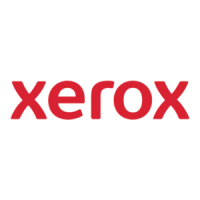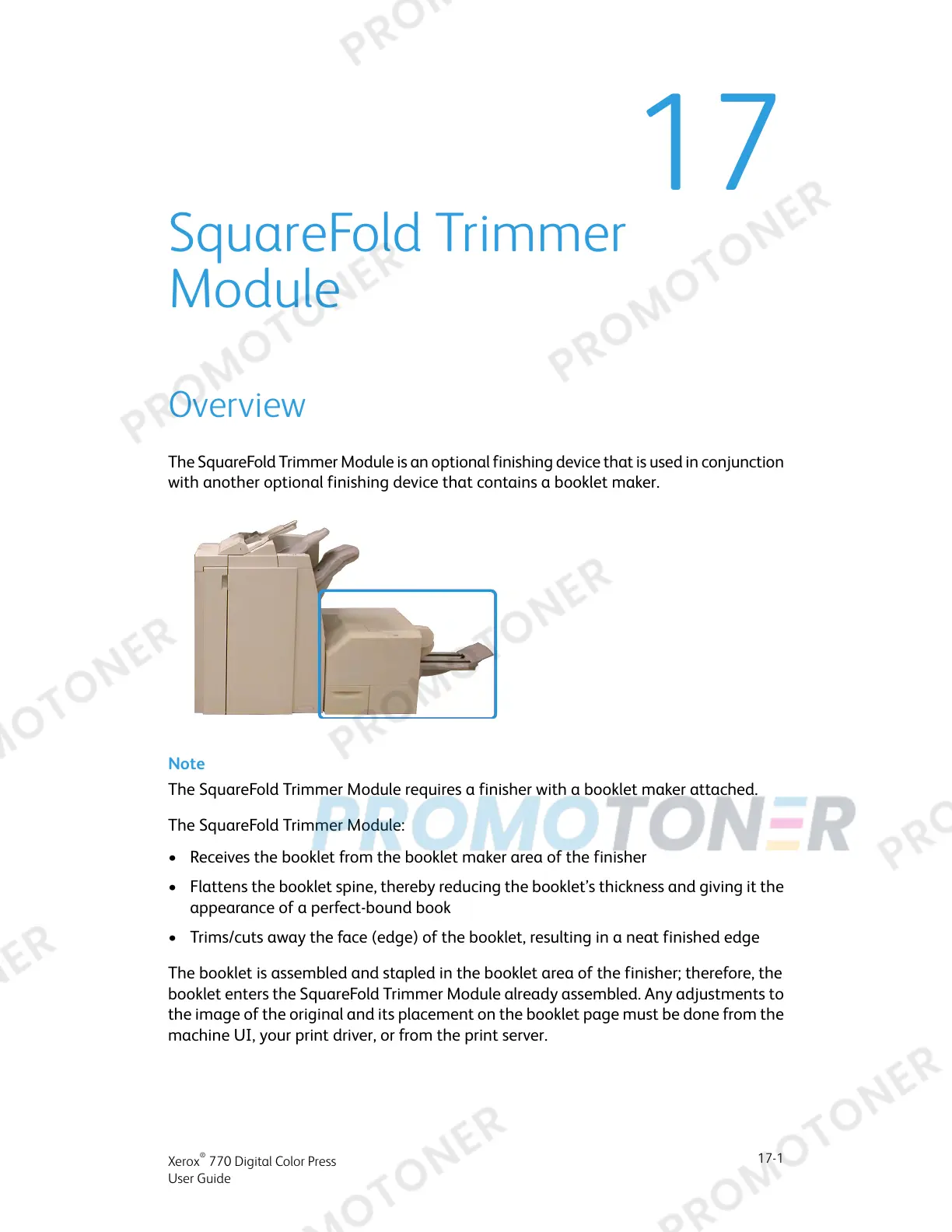

Do you have a question about the Xerox 770 and is the answer not in the manual?
| Brand | Xerox |
|---|---|
| Model | 770 |
| Category | Office Equipment |
| Language | English |
General introduction to the Xerox 770 Digital Color Press capabilities and upgrades.
Detailed descriptions of the main physical components of the machine.
Description of the bypass tray's function, capacity, and media handling.
Details on the document feeder's capabilities and usage tips for scanning.
Explanation of the touch screen and control panel functions for machine operation.
Information on print servers compatible with the digital press for job management.
Overview of optional feeding and finishing devices available for the machine.
Description of the 1-tray High Capacity Feeder for large paper quantities.
Details on the OHCF available in 1 or 2-tray options for various stock sizes.
Information on the GBC AdvancedPunch accessory for document punching options.
Description of the Interface Module required for all optional finishing devices.
Details on the HCS optional finishing device for stacking and offsetting output.
Information on finishers providing finishing and folding options for output.
Description of the SquareFold Trimmer Module for booklet finishing.
Information on additional third-party Document Finishing Architecture (DFA) devices.
Steps for powering the machine on and off, including warm-up time.
Explanation of the machine's Low Power and Sleep Mode features.
Instructions on how to find the machine's serial number for support.
Information on accessing user guides from the provided CD/DVD.
Details on accessing print server documentation shipped with the server.
Resources for support and documentation available on the Xerox website.
Steps for printing PDF files directly from a computer to the printer.
Procedure for submitting print jobs via the Xerox FreeFlow Print Server.
Instructions for submitting print jobs via the Xerox EX Print Server.
Instructions for loading various media types into the main paper trays.
Guidance on loading paper, tab stock, and transparencies into the bypass tray.
Instructions for loading media into optional feeding devices.
Guidance on loading media into optional finishing devices for post-processing.
Specific instructions for loading tab stock with the GBC AdvancedPunch.
Steps for performing basic copying using the document feeder.
Instructions for performing basic copying using the document glass.
Overview of features available on the Copy tab: Reduce/Enlarge, Paper Supply, Output Color.
Adjustments for Original Type, Image Options, Enhancement, Effects, Balance, and Shift.
Options for adjusting layout: Book Copying, 2 Sided Copying, Original Size, Edge Erase, Image Shift.
Features for output format: 2 Sided Copying, Booklet Creation, Covers, Transparency Options, Page Layout.
Features for assembling jobs: Build Job, Sample Job, Combine Original Sets, Delete Outside/Inside.
General information on the network scanning feature and its capabilities.
Explanation of how templates are used to control network scanning workflows.
Step-by-step instructions for performing a network scan.
Introduction to checking active, pending, and completed print jobs.
Information on viewing and managing currently active or pending jobs.
Accessing details and history of previously completed print jobs.
Accessing Secure Print, Sample Set, and Delayed Print job features.
Accessing machine serial number, software, configuration, and status details.
Viewing current faults, messages, and fault history for troubleshooting.
Checking the status of customer replaceable units (CRUs) and consumables.
Viewing billing meters, usage counters, and account information.
Accessing utilities like Stored Programming and Paper Tray Attributes.
Instructions for cleaning the exterior, document cover, glass, and feeder rollers.
Information on ordering, checking status, and replacing CRUs like toner and drum.
Step-by-step guide for replacing the toner cartridge.
Procedure for replacing the toner waste bottle.
Detailed instructions for replacing the drum cartridge.
Procedure for replacing the charge corotron.
Step-by-step guide for safely replacing the fuser unit.
Troubleshooting steps for clearing jams in various locations like document feeder, trays, and bypass.
List of fault codes, possible causes, and recommended solutions for machine errors.
Solutions for common issues like power, messages, stacking, touch screen, and feeding problems.
Troubleshooting steps for common image quality problems like dark background, lines, or faint output.
Helpful advice for extending fuser life and general machine operation.
Technical details about the print engine, paper handling, and warm-up times.
Information on specifications for optional accessories like the Foreign Interface Kit.
Introduction to the 1-tray High Capacity Feeder and its intended use.
Instructions for loading paper into the High Capacity Feeder.
Troubleshooting steps for clearing jams and understanding HCF fault codes.
Instructions for installing and using the postcard bracket for small media.
Guidance for loading paper, tabs, transparencies, and pre-drilled stock into the OHCF.
Explanation of skew adjustment levers for improving paper feed accuracy.
Troubleshooting steps for clearing OHCF jams and understanding OHCF fault codes.
Technical details and specifications for the Oversized High Capacity Feeder.
Introduction and identification of the Interface Module's components.
Explanation of the control panel buttons and indicators for paper curl settings.
Description of the media path and how to adjust paper curl settings.
Information on the ILS for internal calibration and profiling capabilities.
Troubleshooting guidance for clearing jams and understanding Interface Module fault codes.
Introduction to the HCS and identification of its main components.
Explanation of the HCS control panel indicators and buttons.
Procedure for safely unloading stacked paper from the Stacker Tray.
Troubleshooting for general problems, jams, and fault codes specific to the HCS.
Highlights the necessity of the Interface Module for finisher communication.
Detailed breakdown of the components within the Standard/Booklet Maker Finisher.
How to use the manual decurling feature to adjust paper curl on output.
Explanation of the folding option and available fold types (Bi-Fold, C-Fold, Z-Fold).
Instructions for loading paper and tabs into the Post-Process Inserter (Tray 8).
Procedures for replacing staple cartridges, waste containers, and punch containers.
Troubleshooting steps for paper jams in various finisher locations and stapler faults.
List of fault codes specific to the Booklet Maker Finisher and their solutions.
Technical details on tray types, supported paper sizes, weights, capacity, stapling, and hole punching.
Introduction and identification of the SquareFold Trimmer Module's parts.
Explanation of the control panel, fault indicators, Square Fold, and Trimmer features.
Details on accessing and selecting Square Fold options for different job types.
Explanation of Trimmer options, settings, and guidelines for booklet trimming.
Advice for printing full-page images on booklets and ensuring proper output.
Troubleshooting steps for clearing jams and understanding fault codes for the module.
Technical specifications including paper size, trim capacity, and paper weights.